KTM’S 2024 ENDURO MODELS: YOUR FAQS ANSWERED
After testing KTM’s radically different 2024-model enduro bikes at the recent international media launch, we can now answer your most frequently asked questions about these landmark new machines.
As widely expected, KTM’s 2024 EXC and EXC-F models have adopted a greater majority of the 2023 MX range’s sweeping changes to engine, frame, subframe, swingarm, bodywork and electronics. But are these 2024 enduro models really as revolutionary as KTM claims? Has the all-new closed-cartridge WP fork materially altered the way they ride and handle? What affect did the two-stroke models’ move from a TPI (Transfer Port Injection) to a TBI (Throttle Body Injection) fuel-injection system have on performance, and how do these 2024 bikes still meet Euro5 emission regs? Has KTM done a good job of adapting the MX models’ all-new and much more rigid frame to the PDS-shod (no linkage) enduro models? Why is it that the mods to the four-stroke engines seem to have been overshadowed? And which of the countless fresh components on these 2024 enduro models genuinely jump out as new and improved?
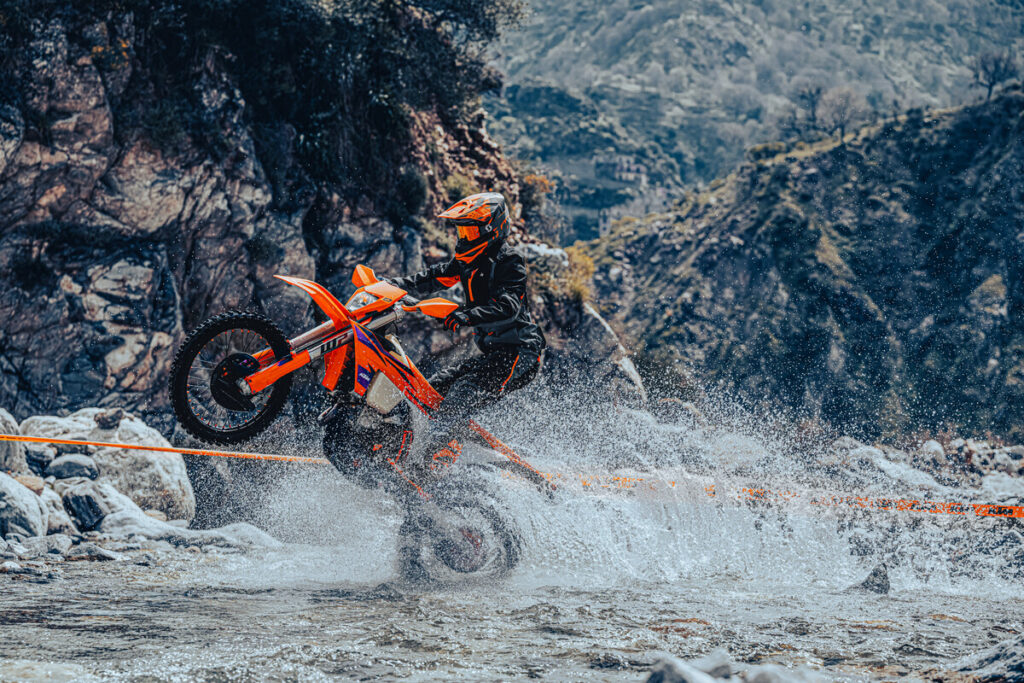
Yes, whenever a manufacturer unveils new-gen bikes, it tends to generate a barrage of questions. And that’s exactly what we’ve copped from our audience in the wake of the recent international media launch for KTM’s 2024 enduro model range – not just because literally 95% of these bikes’ parts are new, but also because they’re based on a completely new design philosophy: the ‘stiff frame concept’. These 2024 models are arguably KTM’s most radically updated enduro machines ever, which is why our first test of these things has been both fascinating and revealing.
From the mountain of questions you guys have thrown at us since our initial video feedback from the international media launch in Lesotho, here are the answers to your most frequently asked ones…
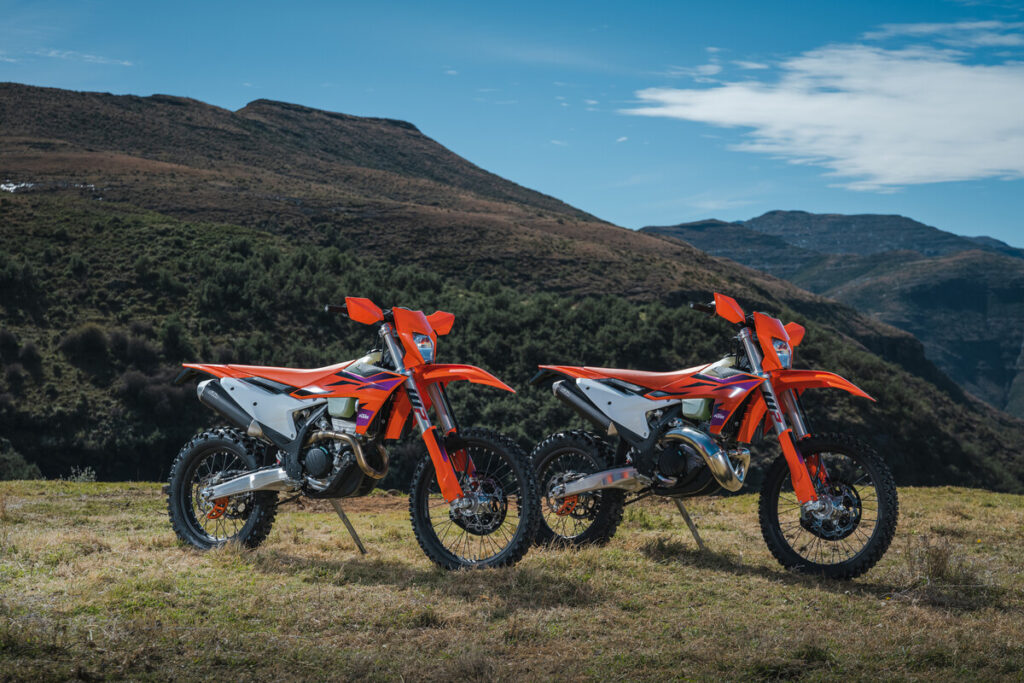
WERE THE BIKES AT THE INTERNATIONAL LAUNCH TESTED IN STANDARD TRIM?
Largely, but not entirely. For added protection against Lesotho’s extreme, rock-strewn terrain, all test bikes were fitted with Michelin mousse tubes and Metzeler 6-Days Extreme tyres (in place of the standard Maxxis hoops), a floating front brake disc, front disc guard, skidplate and handguards (as not all worldwide markets fit both to all models), and the bar-mounted map-selector switch (which only comes as standard equipment on the four-stroke models in some countries). A few of the test bikes were also fitted with the odd KTM PowerParts Accessory, simply to give journos the opportunity to sample their impact on performance.
EVERYONE IS REFERRING TO KTM’S 2024 ENDURO MODELS AS “NEW-GENERATION” OR EVEN “RADICALLY DIFFERENT”. BUT HOW NEW ARE THEY REALLY?
Understandably, a lot of attention has been focused on two key upgrades – the range’s all-new closed-cartridge WP fork and the two-strokes’ TBI (Throttle Body Injection) EFI system – partly because neither was widely expected to appear on these 2024 enduro models. But the reality is that the 2024 refresh runs way, way deeper than suspension and fuel injection upgrades. Literally, 95% of the range’s components are new. Brakes, clutch, hubs and wheels are pretty much the only bits carried over from their predecessors. The 2024 bikes are instantly recognisable because everywhere you look – frame, subframe, bodywork, engine, swingarm, suspension, plus a whole heap of running gear – they’re noticeably different from what came before them. All of which means these 2024 models are every bit as “new-generation” as KTM’s landmark new enduro-model platforms released in 2012 and 2017. In fact, because the 2024 range uses a completely new ‘stiff frame concept’ design philosophy, you could argue they represent KTM’s most radically updated enduro machines ever – or at least since 1998. And when you first lay eyes on these bikes, you get the immediate sense they’ve leapt forward several years in one.
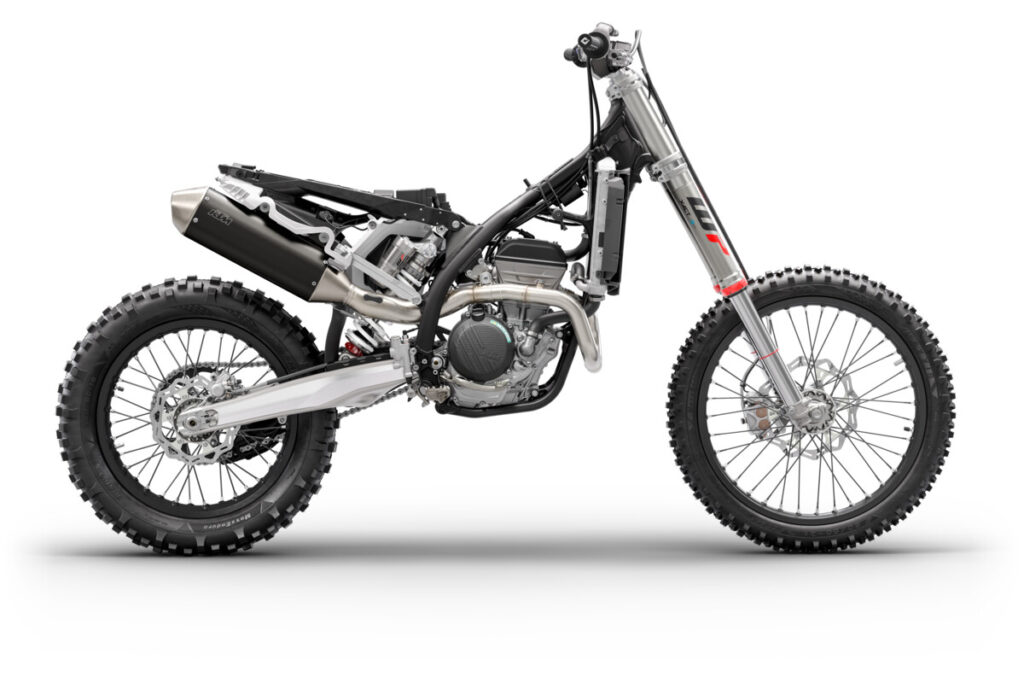
HOW DOES THE ALL-NEW WP XACT 48MM FORK – THE FIRST CLOSED-CARTRIDGE FORK TO BE FITTED TO A KTM PRODUCTION ENDURO MODEL – AFFECT THE BIKES’ OVERALL RIDE AND HANDLING?
In short, it creates a noticeably firmer and racier feel to the 2024 bikes’ overall ride and rewards riders who can push it. Compared with the XPLOR open-cartridge fork, WP’s XACT Closed-Cartridge fork probably gives away a little initial-stroke plushness in slow-speed, technical terrain (using the standard compression clicker settings, anyway), but it delivers noticeably more control and progression through the stroke and a lot more bottoming resistance when it comes to big hits and G-outs. And that added versatility – which is what exactly what you’d expect from a closed-cartridge fork – means a more comfortable ride across a wider range of terrain. Most significantly, though, this new fork gives the 2024 chassis a much more neutral front-to-rear weight bias – especially on the four-stroke models – by holding the fork up in its stroke more consistently. Gone is that nose-down feel that heavier, faster riders have long criticised the XPLOR fork for and, as a result, the new rolling chassis has a more stable, planted, sure-footed feel – particularly at high speed. These new bikes are less prone to getting unsettled or knocked off line by large impacts, and that gives you the confidence to attack bigger obstacles with more aggression. For those of you who’ve sampled WP’s $2000 aftermarket XPLOR Pro 6500 Cartridge-Kit fork … well, this XACT Closed-Cartridge fork feels much the same. Which makes sense as their designs are very similar. Admitted, there’s no external spring preload option on the production XACT CC fork, but this can be purchased as a PowerParts Accessory.
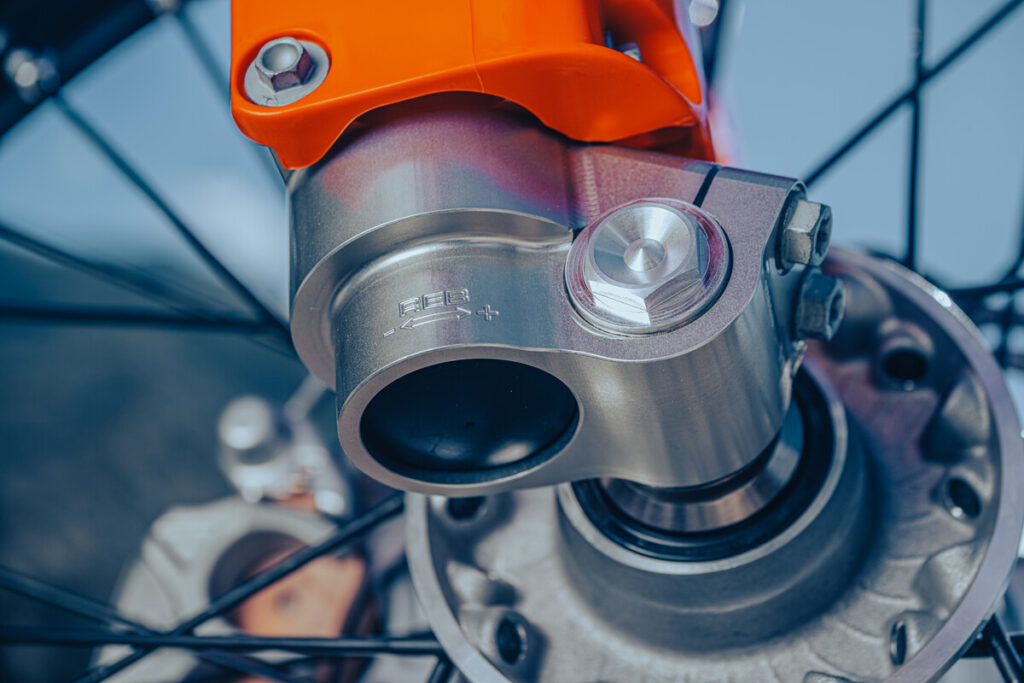
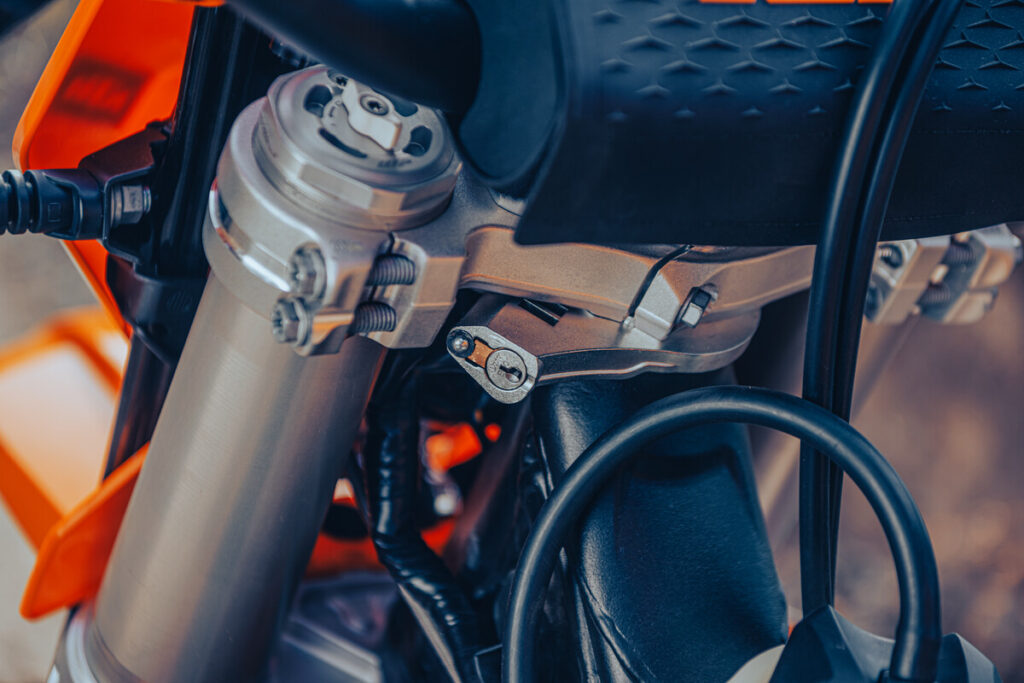
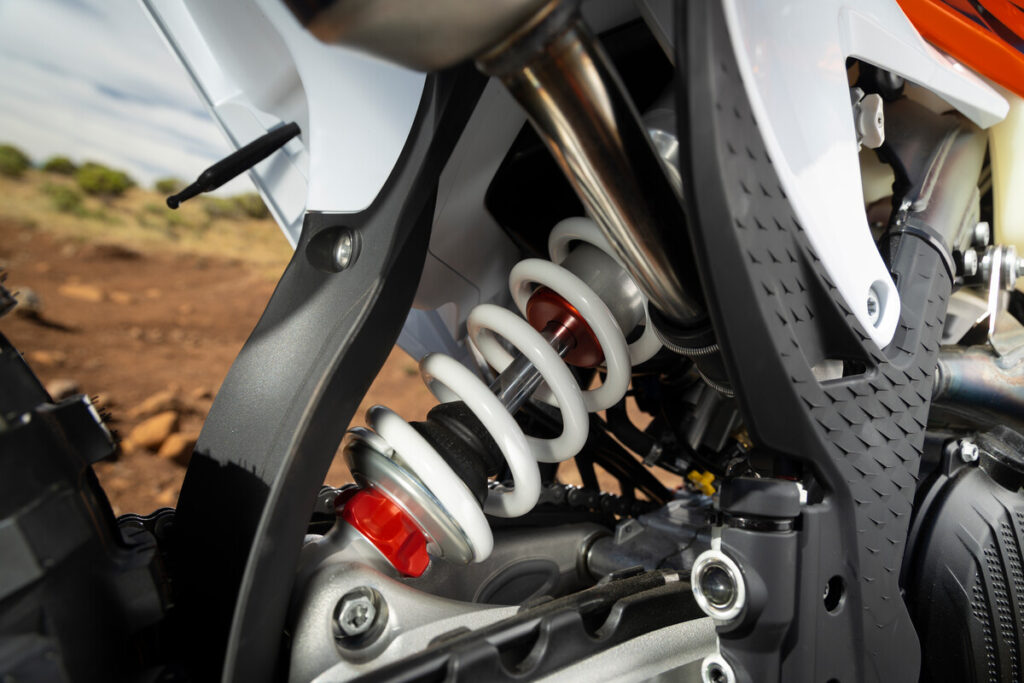
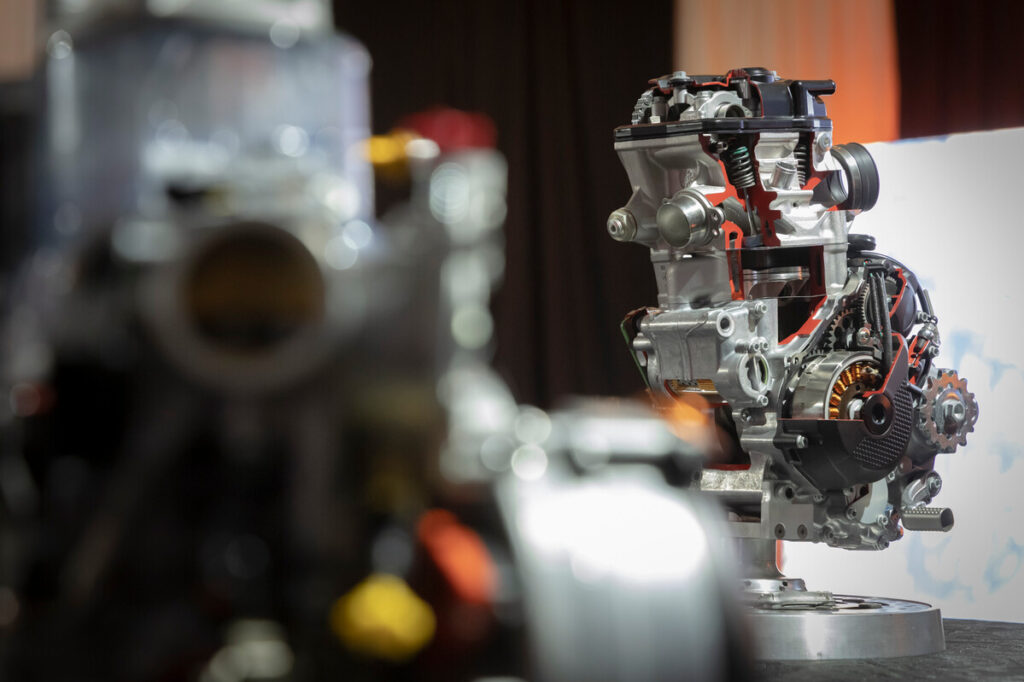
DO THE DIFFERENT CAPACITIES STILL USE THE SAME SPRINGS RATES AND DAMPING SETTINGS?
Thankfully, no! For 2024, KTM has reverted to using dedicated spring rates and valving settings for the different capacities, rather than the one-size-fits-all approach that they took with several EXC and EXC-F models between 2020 and 2023. Given the different weight bias and engine braking character across the model range, it makes sense that suspension settings are not part of the design standardisation process.
DIDN’T THE PDS SHOCK ALSO COME IN FOR SOME NOTABLE CHANGES?
It sure did. Unlike the new WP XACT CC fork, it’s still called a WP XPLOR PDS shock absorber, but it’s had a major overhaul for 2024. It’s more compact, 380g lighter, and gets a bunch of new internals – all designed to work in harmony with the all-new anti-squat, stiff frame concept. While you can understand why the new closed-cartridge fork has stolen the limelight, the much-revised PDS shock’s performance gains shouldn’t be underestimated. Just like up front, this new shock gives the 2024 bikes a noticeably more planted and confidence-inspiring rear-end ride, under both acceleration and braking. And it seems to work especially well in combatting unwanted wheelstands when climbing snotty hills. Notably, this new PDS shock also comes with two added conveniences: identical bearings for its upper and lower mounts, and tool-free clickers all-round.
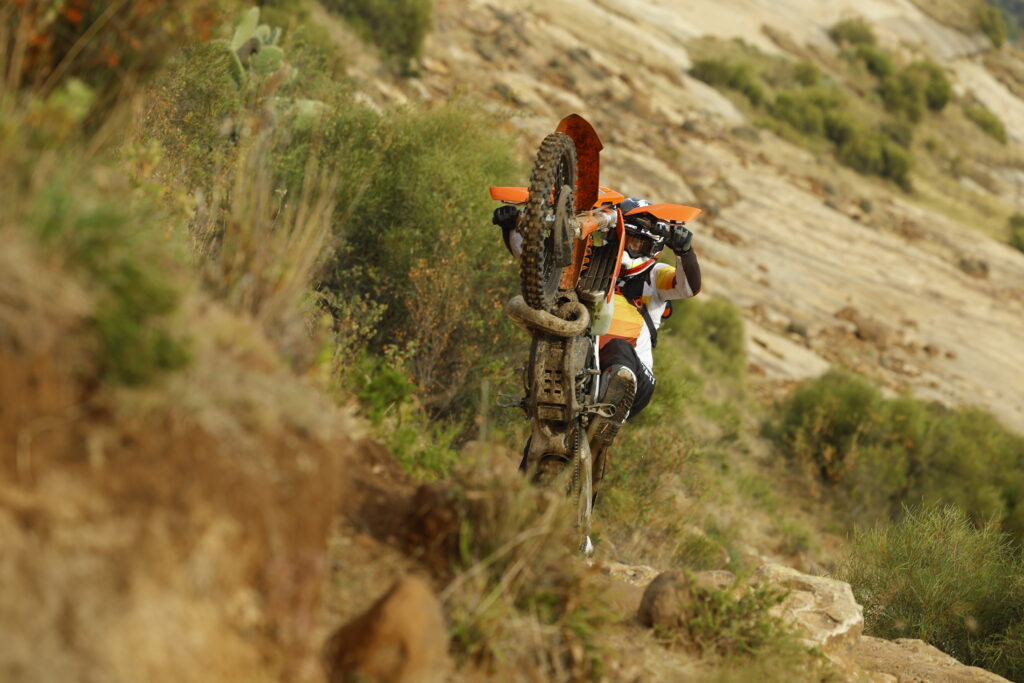
HOW HAS KTM MANAGED TO ADAPT THE MX MODELS’ RIGID FRAME TO THEIR 2024 ENDURO MODELS, AND STILL ENSURE THEY DELIVER A COMPLIANT RIDE FOR OFF-ROAD TERRAIN?
On paper, it may seem like the all-new fork and shock headline these 2024 models’ upgrades. But in really, the most significant change to the 2024 enduro range is the frame, which is now much closer to the frames used on their MX-model counterparts than ever before. And compared with the 2023 EXC/EXC-F models, the 2024 enduro frame is between 20 and 30% more rigid – depending on which axis you’re talking about. This ‘stiff frame design concept’ – explained at some length by KTM’s Off-Road Product Manager, Fabian Gusta – is the platform around which all the other changes revolve. And that flies in the face of conventional wisdom. What do we mean by that exactly? Well, in the past, KTM’s enduro-model frames used a different geometry, different wall thickness in several areas, and visibly less gusseting around the steering head when compared with the MX models – all of which was designed to give them a more forgiving and compliant off-road ride. But for the 2024 enduro models, rather than building that additional flex into the frame itself, KTM’s design team has created compliance by targeting other design elements where flex characteristics can be better controlled. For example, the enduro frame’s all-new lateral bridge (which houses the PDS’s upper shock mount) is critical in introducing longitudinal flex into the frame. Similarly, the enduro models’ frames are more flexible around the swingarm pivot (in that forged section that hides behind the frame guards) because that works much more effectively with the PDS shock absorber. Plus, other components on the enduro bikes – such as the triple clamp assembly (including a new high-flex steering stem) and engine mounts – are also designed to be more flexible than their MX-model equivalents. In other words, the ‘stiff frame’ is there to lay the foundation for straight-line stability, while the fork and shock are left to do what they’re supposed to do: independently absorb impacts.
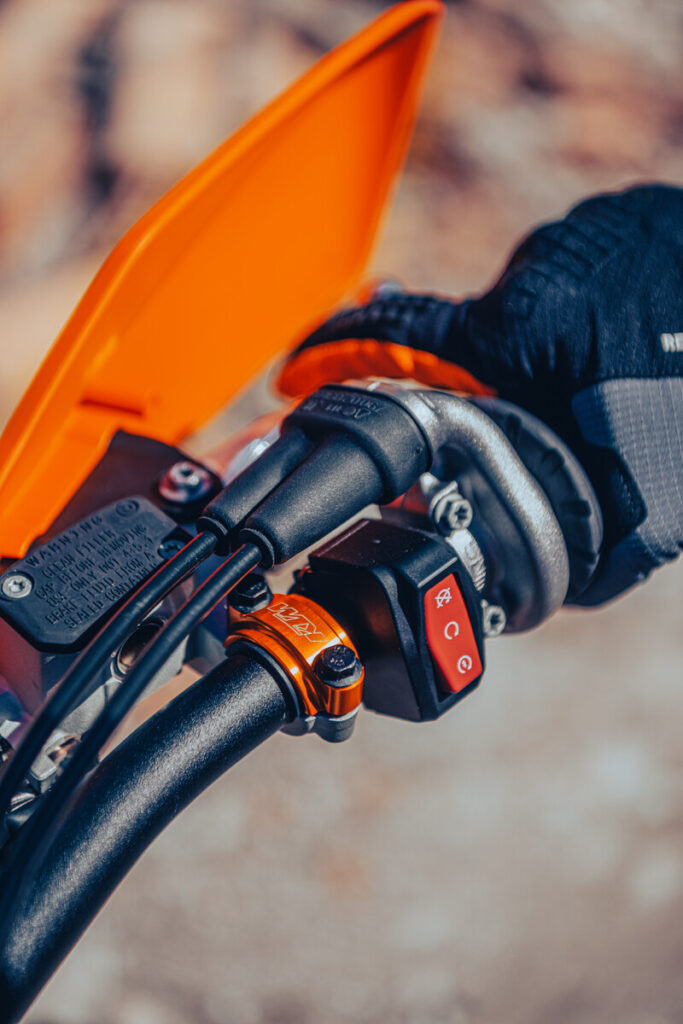
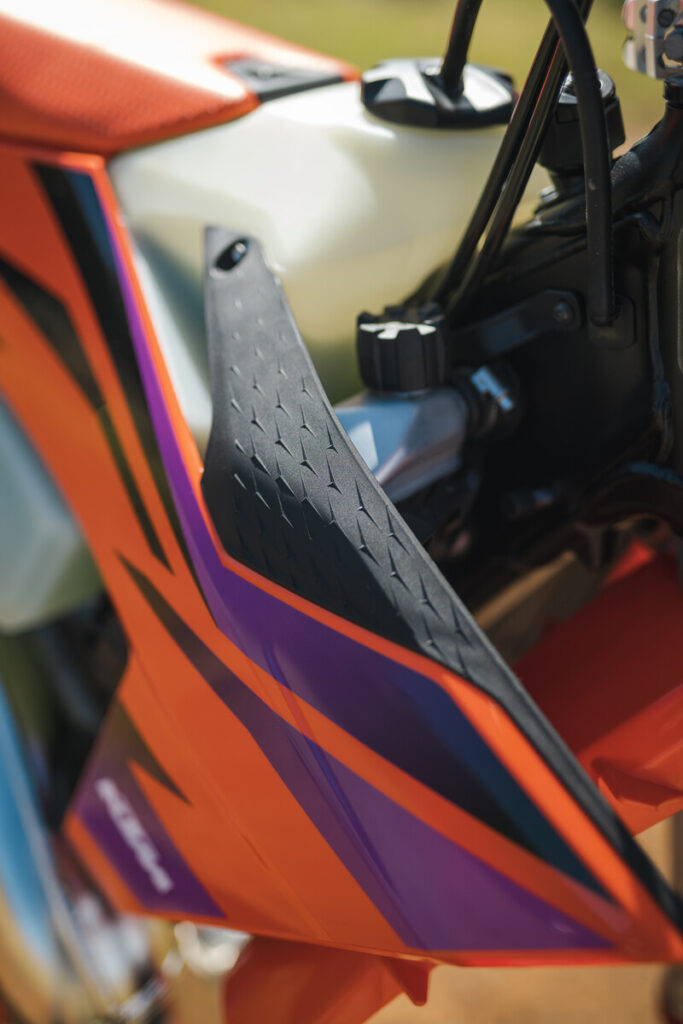
THE 2024 BIKES’ BODYWORK SURE LOOKS DIFFERENT, BUT IS THERE A NOTICEABLE CHANGE IN THE FEEL OF THE ERGOS WHEN RIDING?
Absolutely there is – and for a few reasons. For one, even though the new radiator shrouds appear very long and pointy from side-on (resembling the shrouds on KTM’s 2012-model MXers), they actually bend inwards significantly at their tips – so much so that the fork legs only just clear them at full lock. When you combine that with the shrouds’ bevelled-over upper edges, the whole front-end of the bike is now way narrower. And that makes it less likely to snag your boots when cranked over in deep ruts (in spite of the slightly lower-bend bars for 2024). For another, with the all-new footpegs being a little lower, further back and mounted farther inboard, the new peg/seat/handlebar triangle creates a stronger stance on the bike. And when you combine that added ankle- and calf-area leverage with the revised shape of the plastics around the bike’s girth, the result is bigger and more symmetrical contact ‘patch’ for your boots and knees, which gives you noticeably more purchase on the bike and takes weight off your arms.
WHAT ARE THE NOTICEABLE CHANGES IN THE 2024 BIKES’ POWER DELIVERY COMPARED WITH THEIR PREDECESSORS?
To be honest, it’s difficult to answer that question with much conviction at this stage because our entire test ride in Lesotho was done at high altitude – like, between 1600 and 2400m above sea level – which sucks power from any internal combustion engine. What we can say is that, even in the thin atmosphere, the fuelling on both the two- and four-strokes was impeccable. And despite the technical nature of the terrain, it was impressive to observe that there was barely a flame-out all day.
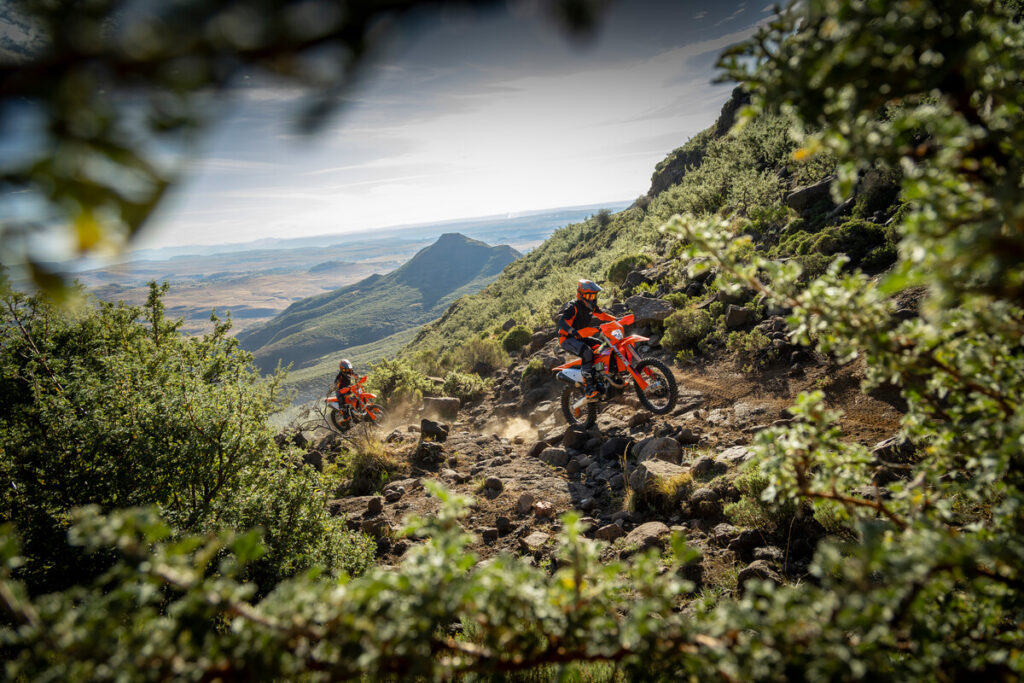
IS IT TRUE THAT THE EFI SYSTEMS AND/OR MAPPING HAVE BEEN SIGNIFICANTLY IMPROVED ON BOTH THE TWO- AND FOUR-STROKES?
Yup. In fact, that’s an understatement. But when we’re talking improvements in EFI, it’s the two-strokes that steal the show. So, let’s start with your questions about two-strokes because their EFI system has come in for the most significant change in 2024.
HOW BIG A DIFFERENCE DOES THE NEW THROTTLE BODY INJECTION (“TBI”) MAKE ON THE TWO-STROKE MODELS’ PERFORMANCE?
A big difference – much of which, it’s got to be said, has to do with the simultaneous introduction of the all-new electronic power-valve system to these two-stroke models. You’ll be glad to hear that the move from TPI to TBI also makes those old TPI idiosyncrasies a thing of the past. No more ‘hunting’ revs at constant throttle openings. No more inconsistent idle speed. And no more wondering which power-valve spring to use. But more importantly, the TBI bikes’ power delivery feels more like a carb-fed two-stroke than the super-linear power that has polarised opinion about the TPI-fed models ever since their appearance in 2018. In other words – and just as we found with KTM’s 2023 two-stroke MX models – the TBI-fed power has a more ‘traditional’ two-stroke character. Obviously, the power delivery differs depending on the model’s capacity, but in general terms you can load the TBI bikes up at very low revs and chug efficiently up slippery rock ledges, and then open the taps to unleash a noticeably more exciting surge of two-stroke power when it comes onto the pipe at higher revs. And in spite of widespread scepticism that this TBI fuel-injection system would not be able to meet Euro5 emission standards, they have – thanks largely to advances in thermo dynamic analysis, according to KTM’s engineers.
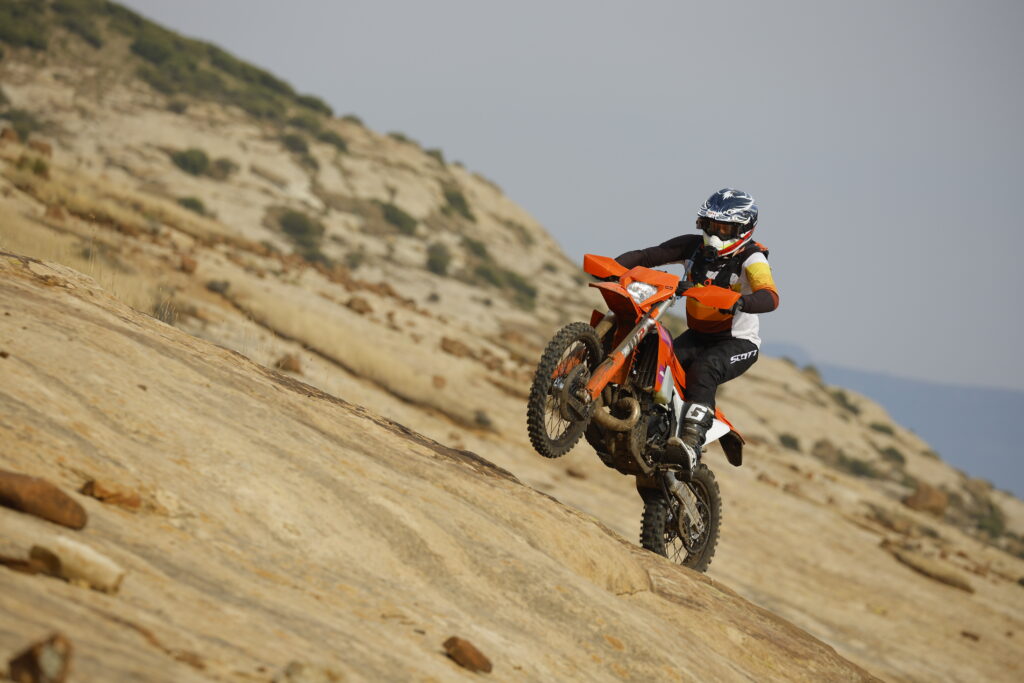
WHAT WAS YOUR FAVOURITE TWO-STROKE, AND WHY?
Like most journos I spoke with at the launch, two two-stroke models stood out – the 150EXC for its sheer potency, despite being a small-bore at altitude; and the 300EXC for its ability to both rock-climb and rev better than the 250EXC – albeit with a slightly less agility when being flicked side to side in tight terrain. And seeing as the 300 and I made it easily up a few intimidating rock ledges where I was certain things would end in tears, this big-bore gets my vote. The other thing worth noting about the two-strokes is the fact their new electronic power-valve has given them genuine dual-map versatility. Rather than their predecessors (which only made ignition timing changes for Map #2), the addition of the EPV means that Map #2 now changes both ignition and fuel settings and is noticeably livelier than the standard Map #1. Thankfully, that also means the two-strokes finally fall in line with the four-strokes in that the green Map #2 is now an aggressive version of Map #1, rather than the other way around. Sadly, it looks like the map-selector switch won’t come standard on the two-strokes in most markets, and will have to be purchased as a PowerParts Accessory.
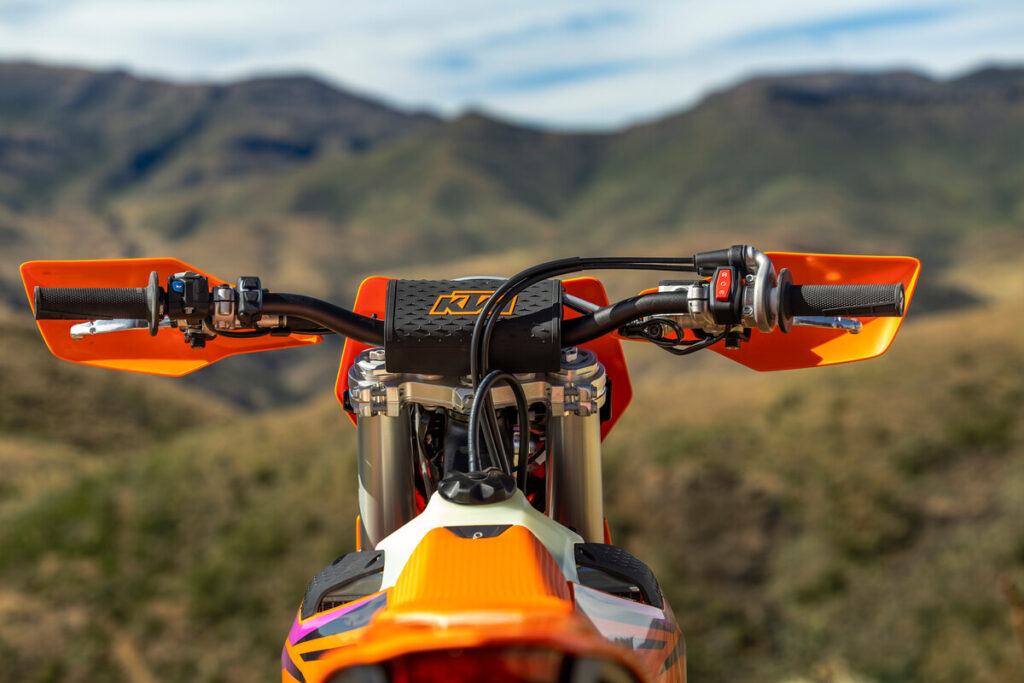
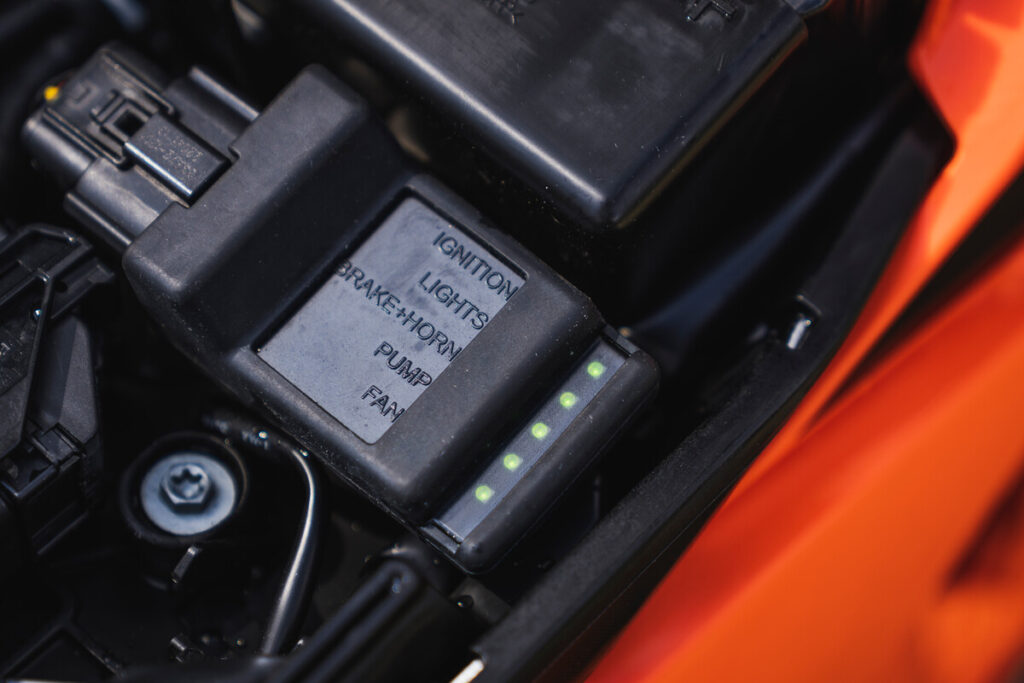
HEY, WHAT HAPPENED TO THE RIBBED EXPANSION CHAMBER ON THE TWO-STROKES?
Good question, and one that I was quick to ask of KTM’s design team when I first clapped eyes on these two-strokes. After all, when the ribbed pipes were introduced back in 2017, KTM had told us they were an unequivocal win-win; that they were stronger than a conventional expansion chambers and they managed to help muffle noise emissions. It turns out that, with the change from the centrifugal to electronic power-valve for the 2024 models, the additional space created allowed KTM to route their expansion chambers in a more compact way – closer to the engine and frame and with more ground clearance – and still find performance gains. In other words, the new design negated the need to reinforce the pipe with ribs, and this also eliminated customer complaints about the added costs associated with removing dents from the ribbed pipe.
WHAT ABOUT THE FOUR-STROKES? WHAT WAS YOUR FAVOURITE THUMPER MODEL?
Riding all four capacities back-to-back really reinforced the differences in their character and abilities, but I found it more difficult than ever before to pick a clear favourite because I reckon every capacity has taken a step forward for 2024, and because each does at least one thing better than the rest. And, just like the two-strokes, the mapping on the four-strokes was spot-on – they were much less inclined to flame-out than their predecessors, even when you gave them a handful of throttle from low revs at over 2000m altitude! As always, the 250EXC-F is brilliantly agile and punches way above its weight in terms of both power and torque – and that’s in spite of its move to an over-square bore-and-stroke configuration for 2024. The 450EXC-F remains the quickest-revving, most aggressive, raciest engine of the four. With the 500EXC-F delivering its longer-stroke, torquer power through a taller final gearing combo, it remains the clear stump-pulling tractor of the quartet, plus it feels like it’s been the biggest beneficiary of the new anti-squat chassis with the rearward tilting of its taller engine paying big agility dividends. That leaves the 350EXC-F, which is often referred to as the best-of-both-worlds all-rounder. For me, the longer I rode the thing, the more I realised it remains the perfect trade-off between power, agility, rideability, fun factor and all-terrain versatility.
DID YOU TRY THE NEW QUICKSHIFTER ON THE FOUR-STROKES?
I did. And it’s been cleverly incorporated into the bar-mounted switchblock that houses the map-selector and TC bottons. But to be honest, the technical terrain at the launch didn’t exactly lend itself to pinned-throttle gearshifts. And, just as we found 12 months ago when this technology first appeared on KTM’s MX models, it does take some time to get used to. Then again, when you come out of the bush after a day’s riding with your mates and cut a few racy laps around a grasstrack before calling it a day, you just might come to appreciate the Quickshifter. In any case, it’s there as a standard option, and can be switched on or off at any time on the fly.
HAS THE ‘STANDARDISATION’ DESIGN PHILOSOPHY FILTERED THROUGH FROM KTM’S 2023 MX MODELS TO THE 2024 ENDURO RANGE?
Yes, and for all the reasons spelled out by the KTM Group’s Rob Twyerould after the release of the new-gen MXers from KTM and Husky a year ago. This is not the first time KTM has built bikes using a shared platform strategy between MX and enduro models, but it’s fair to say that KTM has taken their standardisation strategy a step further with their 2024 enduro machines. And not just with the shared main frame and subframe. The MX and enduro models now share the same frame geometry, seat, bodywork (aside from tank and headlight, of course) and footpegs – just to name a few. And then within the enduro range itself, there are only three different frames (one for the 150EXC, one for the 250/300EXC, and one for the 250/350/450/500EXC-F four-strokes) and two different transmissions (one for the 150EXC, and one for the other six models) – albeit with different secondary and final gearing. Essentially, KTM has now unified many parts, but only where it has made sense.
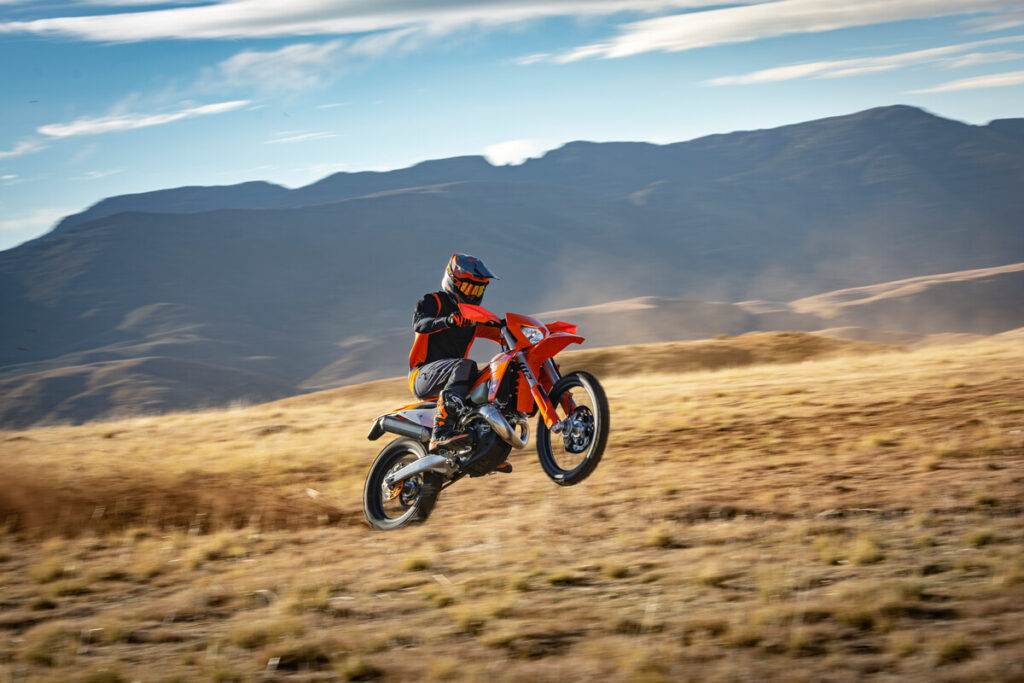
WHICH OF THE 95% OF NEW COMPONENTS REALLY STOOD OUT AS GENUINELY NEW AND IMPROVED?
When you’re eyeballing at a range of bikes that boast so many new parts, it’s difficult to know where to look and what to draw attention to. But here are the items that made their way into my notebook after poring over these new machines at the launch and then riding them for 140 of the most gruelling kilometres I’ve ever done:
- Sidestand – forged, sleek and strong, but a bit awkward to flick down with a set of boots on.
- Chain guide and chain slider – cleverly made, more durable versions of their predecessors.
- Handguards – big, robust, effective protection against tree strikes and crash damage, but not the prettiest things.
- Headlight – now LED and three times more powerful than the 2023 version.
- Skidplate – conforms to the frame cradle way better than before and offers the engine cases noticeably more protection.
- Switchblocks – sleek, modern and functional, with the recessed kill switch preventing inadvertent chest strikes.
- Tool-free clickers (on both fork and shock) – what better way to encourage owners to fiddle with suspension settings and find the optimal set-up for them?!
- Electronics – the under-seat OCU (Off-road Control Unit) headlines an all-new electronics package by not only doing away with those agricultural-looking fuses and relay switches; but also helping with electrical troubleshooting. The addition of the ‘rollover’ tech makes a lot of sense for enduro riding too.
- Handlebar mounts – more crash-proof, thanks to the new one-piece upper bar clamp and larger clamping surface area.
- Bar pad – bigger is better unless it’s getting in the way of your view of the instrument (which it doesn’t).
- Textured surfaces – from gripper seat to special patterns on frame guards, engine covers and shrouds, KTM has clearly put a lot of thought into the durability of every single component.
- Quality plastics – gone are the days when plastics appear one step removed from ice cream containers; these things are now high gloss, super-strong precision parts.
- Rear wheel wizardry – an ingenious little lip has been machined into the LHS swingarm and rear brake calliper, so the rear wheel now sits in place without the axle inserted.
- Radiator louvres – the removal of the lower cross-member means leaves and grass can now be easily cleared, plus the front guard’s fins are designed to deflect mud away from the radiators.
- Serviceability – with key bolts’ torque settings and “oil” or “fluid” now cast into engine cases, and arrowed reminders where copper washers need to be fitted, owner maintenance is now idiot-proofed.
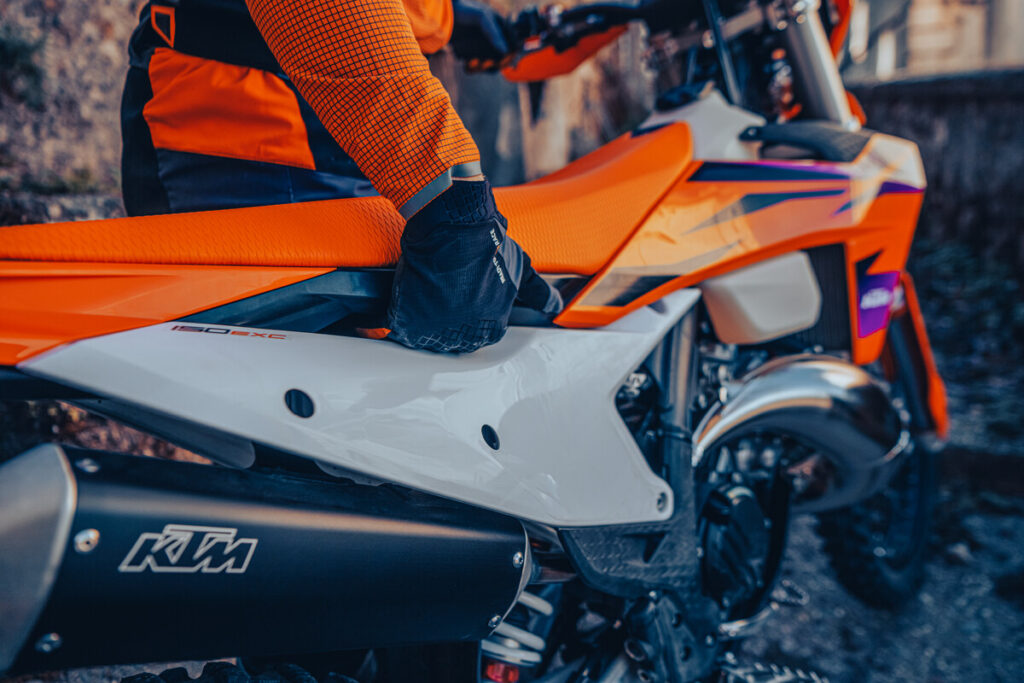
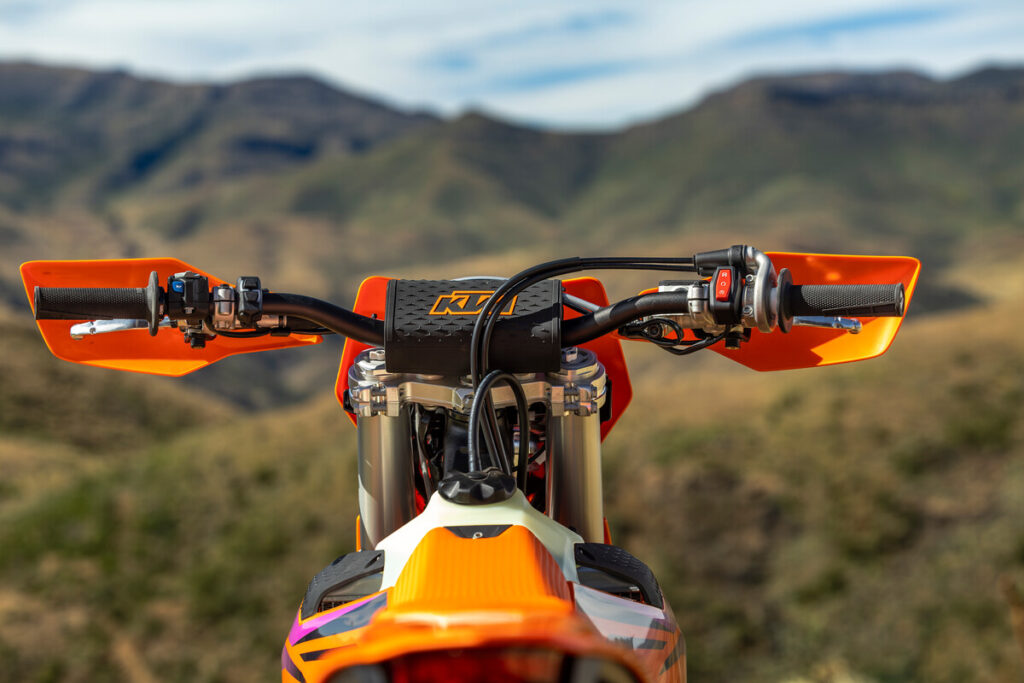
ARE THESE BIKES LIKELY TO COME WITH HEFTIER PRICE TAGS WHEN THEY ARRIVE ON AUSSIE AND KIWI DEALER FLOORS IN SEPTEMBER?
KTM Australia is yet to announce pricing for the 2024 models, but you’d have to think an MSRP increase is on the cards – because if there was ever a compelling reason to hike prices, these new-gen 2024 models provide it. Then again, if you listen to KTM dealers – who say a large proportion of customer have been paying for mods to the standard XPLOR fork (or fitting WP’s $2000 XPLOR Pro 6500 closed-cartridge kit) before their bike even leaves the showroom – then the net cost for these customers may even come down a tad in 2024. Pricing is always an evocative issue, so it’ll be interesting to see what transpires.
HOW WAS IT GETTING TO RIDE THOSE NOTORIOUS ROOF OF AFRICA TRAILS IN LESOTHO?
Epic! It was a memorable experience in mesmerising terrain, but I felt like I’d been run over by a bus for a few days afterwards!
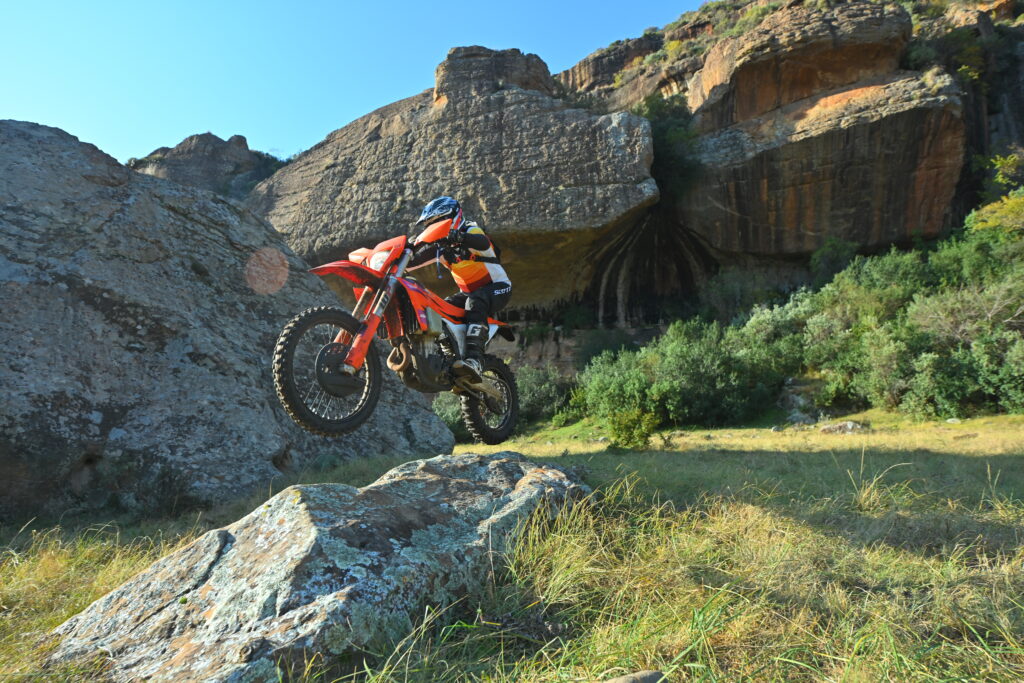
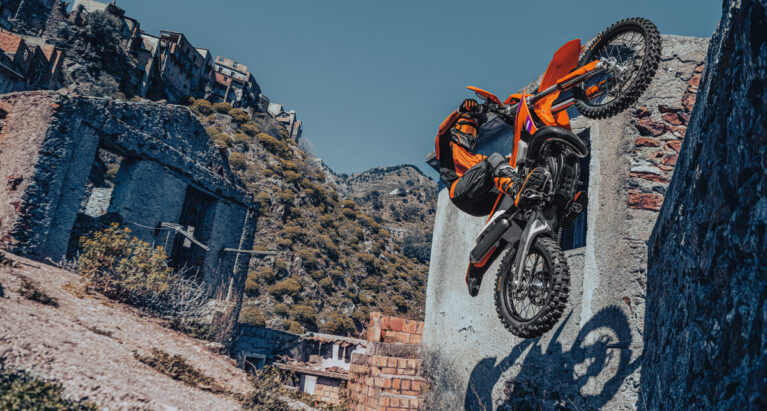

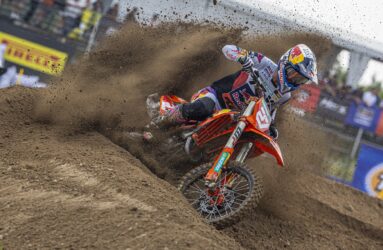

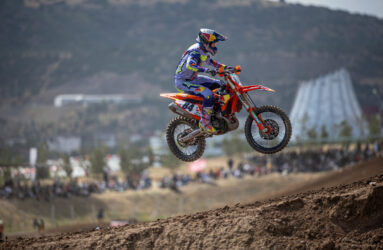

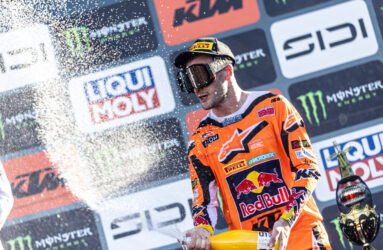
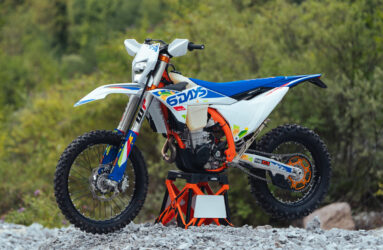

Be the first to comment...